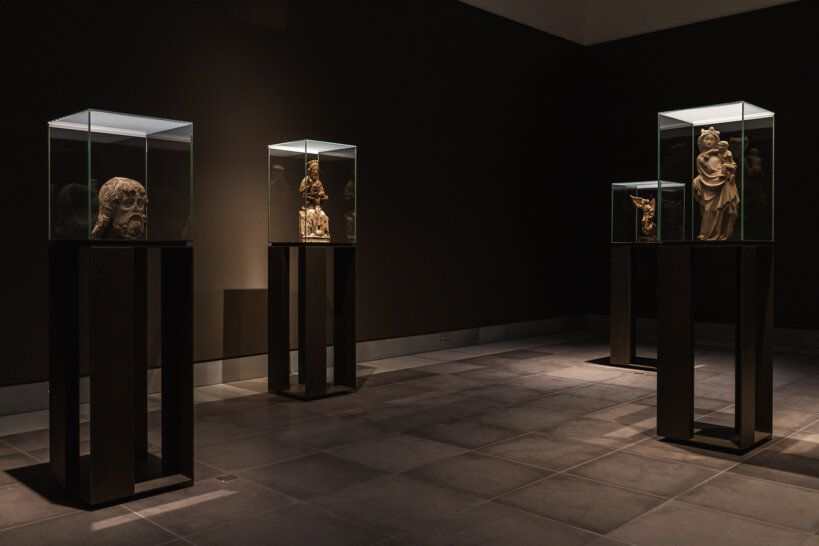The exhibition ‘Among Friends’ begins in a gallery devoted to medieval sculpture. A particularly striking work is the marble Virgin and Child in the middle of the gallery. A gift from the family of sculptor Philip Van Isacker, it is on display in the MSK for the very first time.
The MSK’s small but beautiful collection of medieval sculptures offers an interesting counterpoint and a valuable addition to its collection of panel paintings from the same period. Fernand Scribe was the generous donor of nearly all of them. His extraordinarily eclectic personal collection included two early medieval sculptures and dozens of late Gothic works. In 1900 he donated the 14th century Head of an Apostle by an anonymous French sculptor, and in 1913 others including some particularly exquisite late Gothic alabaster works.
One of these, a large Virgin and Child in a style reminiscent of Van Eyck, has over the years come to be known as the Scribe Virgin. The Friends of the Museum followed in Scribe’s footsteps by making valuable additions to the small core collection, among them the 1986 gift of the Madonna on a Crescent Moon (1430-50). In 1988 the museum acquired what could be considered the missing link in its collection of alabasters, an early 16th century sculpture of a Hovering Angel, a work of outstanding artistry that represented a stylistic shift from the late Gothic to Mannerism.
The collection remained stable throughout subsequent decades until the unexpected 2021 addition of its first medieval work in marble. A standing figure of a Virgin and Child was the very special gift of the family of artist Philip Van Isacker, and the exhibition Among Friends marks its first public display. Before inheriting the statue, Van Isacker had grown up with it, seeing it mounted on a plinth in the sitting room of his grandfather Philippe Van Isacker, a Catholic politician and government minister from 1931 to 1938. Philippe had inherited it from his own father, Philogeen, who acquired it on 15 April 1892 through the purchase of a plot of land from the municipalities of Gits and Lichtervelde.1 On this land stond a roadside chapel flanked by two linden trees, referred to today as the ‘little white chapel’ (or Verhelles or Dierendonck chapel), in which the sculpture had been placed as an object of devotion.2 According to Van Isacker family lore, regular visitors to the chapel found the madonna rather plain, and asked the family to exchange her for one with a bit more colour and flourish.
So far, results of ongoing stylistic analysis, which has also focused on the quality of the drapery in the robe and mantel and the refined rendering of the right hand, have suggested it was made in France sometime around 1350 to 1370.3 But the head is most probably a later addition, more difficult to date but apparently in the style of the 14th century. Like other sculptures that belonged to Scribe’s collection it bears clear signs of damage, possibly inflicted by iconoclasts during the Beeldenstorm era. The Van Isacker family’s generous donation helps now to refocus attention on this small collection of medieval sculpture, not only among museum researchers but also among visitors.
1 We are particularly grateful to Luc Haegebaert, Rik Pollet and Hendrik Vandeginste for their assistance during research into the provenance of the work. In the Municipal Archives of Brugge Mr Vandeginste rediscovered the deed of sale by which Philogeen Van Isacker (1855–1933) acquired his land. It states that lot E132B was sold to Philogeen by the wagoners Reynaert and Vandendriessche from Roeselare, who had in turn acquired it from Adèle and Josephine Gérard, traders from Roeselare, on 8 April 1885 through a notary public in Rumbeke named Crevits. The plot was described as follows: ‘Municipality of Gits / 4°, | on the opposite side of the road a plot of fertile land in two lots, upon the most westerly of which is constructed a small chapel measuring nine and sixty ares and eighty centiares in size, recorded in the land registry as section E numbers 132a, 132b, 133 and 138’.
2 For more information about the chapel, see the municipal guide for the chapel route in Lichtervelde (https://issuu.com/cultuurdienst.lichtervelde/docs/kapelroute_folder_a5).
3 We would like to thank the following specialists for their contributions to the stylistic analysis: Marjan Debaene, Dr Sophie Jugie, Dr Ingrid Geelen, Professor Maximiliaan Martens, Dr Hans Nieuwdorp, Dr Pierre-Yves Le Pogam and Judy Leroy.





